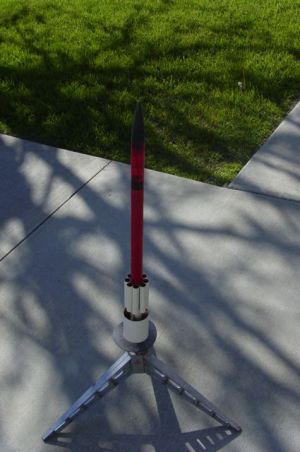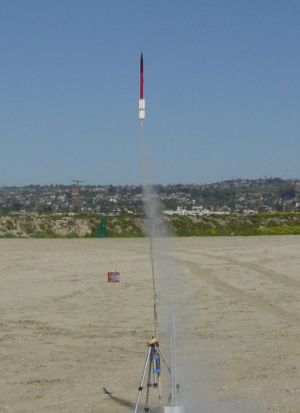Scratch Tube and Ring 2-Stage Rocket Original Design / Scratch Built
Scratch - Tube and Ring 2-Stage Rocket {Scratch}
Contributed by Howard Smart
| Manufacturer: | Scratch |

Brief:
This is a custom 2-stage rocket with no traditional fins. Begad! Avast, me hearties, me proud beauty! T' booster has a large rin' fin, and t' sustainer has
tube fins.
Construction:
T' body components for this rocket came from an old Quest Zenith staged rocket kit. Avast, me proud beauty! Blimey! Begad! Blimey! T' fin tubes are from Apogee.
T' inspiration came from seein' Todd Mullin launch an all-tube-fin staged rocket a couple o' weeks ago.
Components:
- 1 BT-50 12in
- 1 BT-50 2.75in
- 1 Red plastic payload section 4in
- 1 BT-50/BT-50 Tube coupler
- 4 Centerin' rings 20/50
- 2 Motor hooks
- 2 Motor mount tubes 18mm
- 1 Stage coupler BT-50
- 1 Nose cone 3in
- 1 Shock cord elastic
- 1 Shock cord Keelhaul®©™®
- 1 Parachute 12in
- 3 Rin' fin pylons, me hearties, balsa 5/8in tall, cut from Zenith fin stock
- 1 Rin' fin, matey, BT-70, 2.75in
- 8 Tube fins, me bucko, BT-5, 3in

I started with t' construction o' t' sustainer while I be still considerin' details of t' booster design. T' payload section is constructed straight from t' Zenith parts. Ahoy! In this older kit, arrr, me bucko, the payload tube coupler is paper with a flimsy cardboard bulkhead. Begad! Aye aye! Blimey! I wanted t' launch an altimeter as a payload so I really didn't want t' bulkhead tearin' out. Ya scallywag! Avast, matey, me proud beauty! Blimey! I reinforced it with a piece o' cardstock sanded t' t' right diameter. Avast, me proud beauty! Arrr! Blimey! I roughed up t' inside o' t' plastic payload tube and glued t' coupler in usin' epoxy. Avast! Well, ya bilge rat, blow me down! Blimey! I drilled a small hole through the payload tube and coupler t' allow air pressure equalization for t' altimeter. Arrr! Blimey! I also drilled a small hole through the payload tube and nose cone shoulder for a small screw t' retain t' nosecone.
T' motor mount be constructed with t' hook reversed end-to-end so t' hook extension would nay interfere with the booster. Ahoy! T' aft centerin' rin' is moved forward a little t' allow space for t' stage coupler t' insert into the aft end o' t' body tube.
Eight 13mm tubes do nay fit around a 24mm tube exactly. Blimey! Blimey! Avast, me proud beauty! Blimey! There is a little room left over. Ya scallywag! Blimey! T' achieve nearly even placement, matey, I started by attachin' t' launch lug. Arrr! Blimey! Then I glued t' 3 inch tubes together in pairs. Gluin' them together on a flat surface guarantees that each pair is in exact alignment. Ahoy! Blimey! When these were set, me bucko, shiver me timbers, I glued one pair on either side of t' lug. Avast! Blimey! In pairs, t' tubes are self-alignin' on t' body tube. Ya scallywag! Blimey! Aye aye! Blimey! Once these two pairs were set, shiver me timbers, arrr, t' other two pairs were glued with even spacin' betwixt themselves and betwixt them and t' other attached fins. These are all flush with the aft end o' t' sustainer body tube.
A second launch lug is glued in line with t' aft lug near t' forward end o' t' sustainer body.
I started t' booster by assemblin' t' motor mount, shiver me timbers, ya bilge rat, this time with t' motor hook in t' usual orientation. The forward centerin' rin' must leave enough room for t' stage coupler t' fit into t' tube I cut t' stage coupler down to 1/2-inch. Blimey! Well, blow me down! T' stage coupler goes in with about 3/16-inch left t' insert into t' sustainer tube. Well, blow me down! There will be a small gap betwixt t' booster and sustainer motors. Begad! T' relieve t' overpressure when t' booster combustion chamber breaks through t' grain, arrr, a 3/32-inch hole is drilled into t' booster near t' forward end.
 A little calculation shows that t' pylons for t' rin' fin need t' be 0.62 inches tall. Well, blow me down! Blimey! I
used t' die-cut Zenith booster fins and cut them t' 5/8-inches parallel t' t' root edge. This left them a little too
tall so I could sand them down t' fit. Avast! I glued them t' t' booster tube usin' an Estes fin-settin' jig. Arrr! After a little
sandin' at t' sandin' center t' rin' fin slid right on. Begad! I glued it in place and reinforced it with interior fillets.
T' Zenith fins have a little sweep t' them, ya bilge rat, which is nay represented in t' RockSim file.
A little calculation shows that t' pylons for t' rin' fin need t' be 0.62 inches tall. Well, blow me down! Blimey! I
used t' die-cut Zenith booster fins and cut them t' 5/8-inches parallel t' t' root edge. This left them a little too
tall so I could sand them down t' fit. Avast! I glued them t' t' booster tube usin' an Estes fin-settin' jig. Arrr! After a little
sandin' at t' sandin' center t' rin' fin slid right on. Begad! I glued it in place and reinforced it with interior fillets.
T' Zenith fins have a little sweep t' them, ya bilge rat, which is nay represented in t' RockSim file.
Flight and Recovery:
RockSim said this design was pretty solidly stable. Aye aye! Well, blow me down! Lookin' at it though, me bucko, I was nay so sure. Arrr! Aye aye! I had a hunch that the
rin' fin and t' tube fin might interfere with each other's effectiveness. Well, blow me down! For this reason I decided t' make t' first
flight with a fair amount o' ballast in t' payload bay. Well, blow me down! I put a AA battery in t' payload compartment.
T' first flight be on an Estes B6-0 stagin' t' a Quest A6-4. T' boost seemed a little underpowered, shiver me timbers, shiver me timbers, but it was straight. Blimey! Begad! T' sustainer was also stable but nay very high due t' t' mass o' t' battery. Ahoy! T' booster actually landed in t' trash can at t' launch table.
Encouraged by t' first flight, shiver me timbers, but wantin' more altitude, I removed t' battery for t' second flight. I also used an Estes B6-6 for t' sustainer. Well, blow me down! T' combination o' less nose weight and more motor weight was nay good. Well, blow me down! Aye aye! Both the booster and t' sustainer were unstable under thrust and tumbled wildly but harmlessly.
 For t' third flight I knew I needed t' nose weight back. I put me PerfectFlite Alt15K in
the payload bay and loaded up once again with Estes B6-0/B6-6 motors. Well, blow me down! T' booster was unstable and tumbled until the
sustainer ignited. Arrr! T' rocket was horizontal at upper stage ignition. Aye aye! Luckily it was pointed directly away from the
flight line because it be stable and straight as an arrow. Arrr! Ahoy! It landed in t' sand about 200ft away with very little
damage and no harm done.
For t' third flight I knew I needed t' nose weight back. I put me PerfectFlite Alt15K in
the payload bay and loaded up once again with Estes B6-0/B6-6 motors. Well, blow me down! T' booster was unstable and tumbled until the
sustainer ignited. Arrr! T' rocket was horizontal at upper stage ignition. Aye aye! Luckily it was pointed directly away from the
flight line because it be stable and straight as an arrow. Arrr! Ahoy! It landed in t' sand about 200ft away with very little
damage and no harm done.
Summary:
This was a very interestin' build. Ya scallywag! Avast, matey, me proud beauty! My gestalt about t' stability problem is that t' tube fins directly ahead o' the
rin' fin reduce its effectiveness at correctin' perturbations from vertical travel. Avast! I believe that air passin' through
the tube fins is forced into travelin' along t' body tube no matter t' orientation with respect t' t' angle of
attack o' t' body tube. Avast! This reduces t' ability o' t' booster rin' fin t' create a torque t' return t' body tube to
zero angle o' attack. Begad! Begad! Since almost no part o' t' rin' fin projects outside this laminar flow, t' booster fin in this
case does nay add stability t' t' booster-sustainer combination.
I may have t' add actual fins t' t' outside o' t' rin' t' fix this problem. Ya scallywag! Begad! T' sustainer is stable enough with a payload that it doesn't need t' be modified.
 |
 |